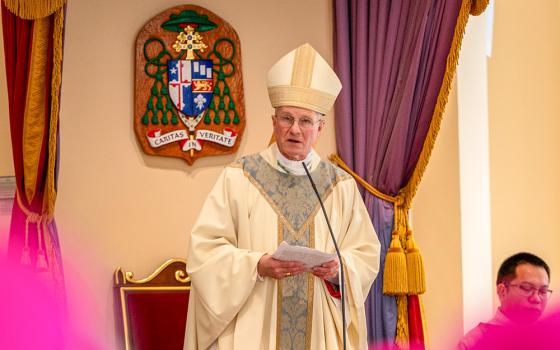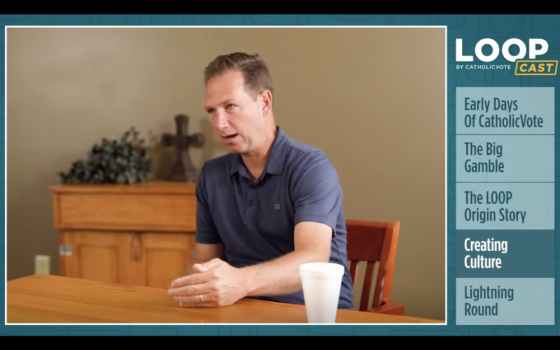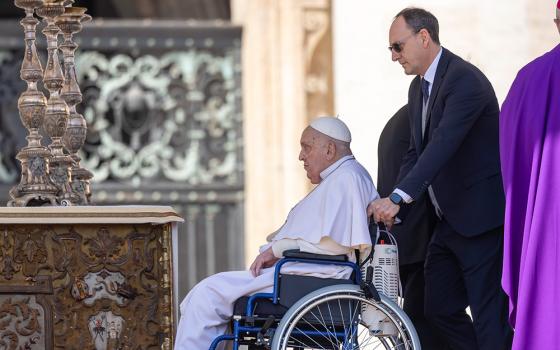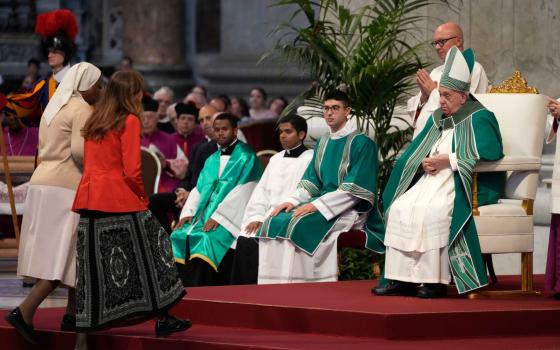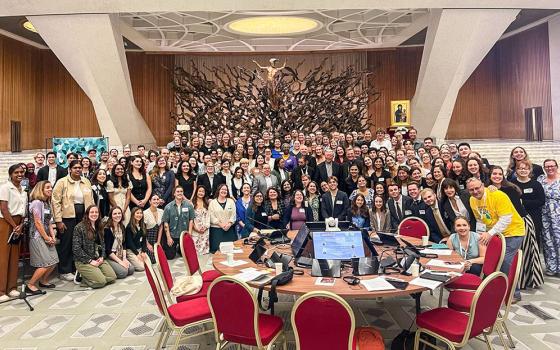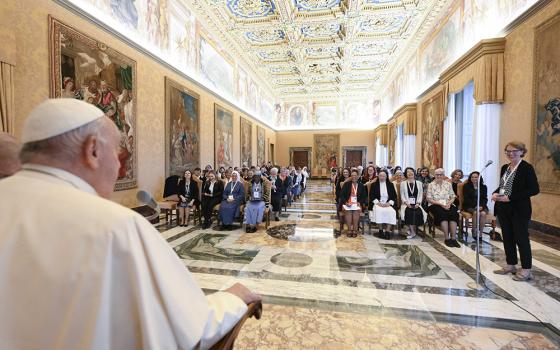Cardinal Mario Grech, secretary-general of the synod, speaks during a news conference at the Vatican July to present the working document for the second assembly of of the Synod of Bishops. (CNS/Lola Gomez)
Many of the hot button issues that dominated Pope Francis' high-stakes summit on the future of the Catholic Church last October, such as women deacons and welcoming LGBTQ Catholics, will be off the table when prelates and lay delegates return to Rome this October for the meeting's concluding monthlong assembly.
Instead, according to a much anticipated document released by the Vatican on July 9, participants in the second session of the synod on synodality will be asked to consider how the church's structures can encourage greater participation and to determine where there is room for "legitimate diversity" among local churches on different issues and practices.
Among the areas identified by the document is the need for women to be more involved in both "decision-making and taking processes" within the church, the possibility of lay women and men preaching at Mass, consideration of how to build a culture of transparency and accountability across the church and the creation of new instituted ministries for listening and accompaniment.
But it also makes clear that some of the most contested issues which have continually surfaced during a three-year consultative process and at last October's Vatican meeting, will ultimately be dealt with by working groups of theologians and Vatican officials set up by the pope, with many of the most sensitive issues falling under the purview of the Vatican's powerful Dicastery for the Doctrine of the Faith.
Advertisement
Last year's instrumentum laboris — the Latin phrase for the working document that guides the synod's discussions — clocked in at 60 pages and enumerated a number of themes and concerns that emerged during thousands of listening sessions that took place around the globe. By contrast, this year's working document, titled "How to be a missionary synodal Church," is half its length and focused on the synodal life of the church by examining its structures, relationships and particular contexts around the world.
Over the last decade, synodality has emerged as a key theme of Francis' pontificate and as a vehicle for implementing the reforms of the Second Vatican Council and instilling them into the practices of the church today.
Last year, Francis overhauled both the methodology and the membership of the synod to include lay men and women and for the first time granted them a right to be appointed as full voting members of the Catholic Church's primary consultative body. During the 2023 assembly, the revised methodology included roundtable "conversations in the spirit" where over the course of the month-long meeting delegates discussed and debated more than 100 particular questions.
The new working document has been drafted based on the results of more than 100 reports from episcopal conferences from around the world and over 200 comments from theologians, religious congregations and outside groups following the October 2023 meeting.
As some 400 synod participants prepare to return to the Vatican for the Oct. 2-27 concluding assembly, the stated goal of the 2024 document is to help guide the diverse body in a "maturing of a consensus" that will eventually be sent to the pope for final consideration.
Women, laity and new ministries
According to the new working document, expansion of the "participation and exercise of co-responsibility" of lay women and men has emerged at every stage of the synod process, which has led to a range of proposals emerging from episcopal conferences from across the globe.
Among the recommendations included in the report are calls more areas for dialogue so women can share their experiences and insights, greater access to positions of responsibility within dioceses and other church institutions, more recognition of the work of consecrated women, inclusion of women in seminary formation, an increase in the women serving as judges in church canonical processes and more inclusive language in preaching, catechesis and official church documents.
But on the much discussed theme of the restoration of the female diaconate — which proved to be the most divisive issue at last fall's assembly — the working document states that it is an issue that will be taken into consideration by one of the study groups established by the pope earlier this year.
In particular, however, it notes that the study group will take into consideration the results of the two commissions previously established by Francis to study the historical questions regarding the ordination of women the diaconate in order to "contribute to its maturation."
Members of the assembly of the Synod of Bishops start a working session in the Vatican's Paul VI Audience Hall Oct. 18, 2023. (CNS/Lola Gomez)
The inclusion of women deacons in the working document and reference to the open nature of the debate is notable, given the pope's own comments on the matter in an interview in May, in which he voiced his firm opposition to the matter. At the time, the seemingly definitive nature of Francis' remarks caught many by surprise given that the issue is an ongoing question in the synod process.
Beyond questions regarding women's leadership, the document enlarges the scope of issues involving the laity more broadly, and proposes the possibility of trained lay men and women preaching during Mass and expanding a number of baptismal ministries that are separate from Holy Orders.
The working document notes that already in certain contexts, church law allows for laity to be designated to coordinate church communities, serve as extraordinary ministers of baptism and to assist at weddings.
"This reflection should be accompanied by further consideration of how we can promote more forms of lay ministry, including outside the liturgical sphere," the document states.
Relationships, pathways and places
While last year's synod working document posed a series of open questions and topics that were divided up among different groups, delegates at this year's assembly will all discuss the same text and proposals, which are divided into three interwoven themes of relationships, pathways and places.
According to the document, delegates will be asked to reflect on the nature of the various relationships in the synodal life of the church "with the Lord, between brothers and sisters and between churches," the intertwined pathways to promoting transparency, accountability and greater co-responsibility and how mature local church discernment can allow for greater diversity that also contributes to a deeper sense of communion and catholicity.
In considering the themes of accountability and transparency — which the document states includes sexual and financial abuse, but also methods of evangelization, working conditions and pastoral planning — the document states that a synodal church must consider the entire community, not just those vested with particular authority.
"While the practice of accountability to superiors has been preserved over the centuries, the dimension of accountability of authority to the community must be recovered," the document states. "Transparency must be a feature of the exercise of authority in the Church."
"Transparency must be a feature of the exercise of authority in the Church."
The document also expands the focus and role of local churches both in ensuring the practice of synodality takes hold at the local level, while also acknowledging that decentralization will likely mean that different churches may adapt different approaches on certain issues.
"Adopting a synodal style enables us to overcome the idea that all Churches must necessarily move at the same pace on every issue," the document states. "On the contrary, differences in pace can be valued as an expression of legitimate diversity and an opportunity for the exchange of gifts and for mutual enrichment. In order to be realized, this horizon needs to be embodied in concrete structures and practices."
During a July 9 press conference to present the working document, Cardinal Mario Grech, who heads the Vatican's synod office, was asked by reporters for clarity on whether the issue of women deacons remains on the table given the pope's recent remarks.
The cardinal said that a deeper theological reflection, which is being headed by the Vatican's doctrinal office, is needed, which could likely result in an eventual separate document.
Despite the document's emphasis on both the role of the laity, and women, in particular, the working document was presented by four male clerics. When asked about the rationale for this, Luxembourg Cardinal Jean Claude Hollerich, who serves as relator-general of the synod, said that greater diversity is "the ideal situation where we want to go," but that the four European clerics at the dais are "the actual situation."
Hollerich went on to stress that while the working document will serve as the outline for the fall meeting, that the "October assembly has to be understood in a worldwide process."
He went on to cite a number of examples, from Korea to Zimbabwe, where he said the synodal method is "already having a significant and multidimensional impact on local churches" that is stimulating pastoral change.

